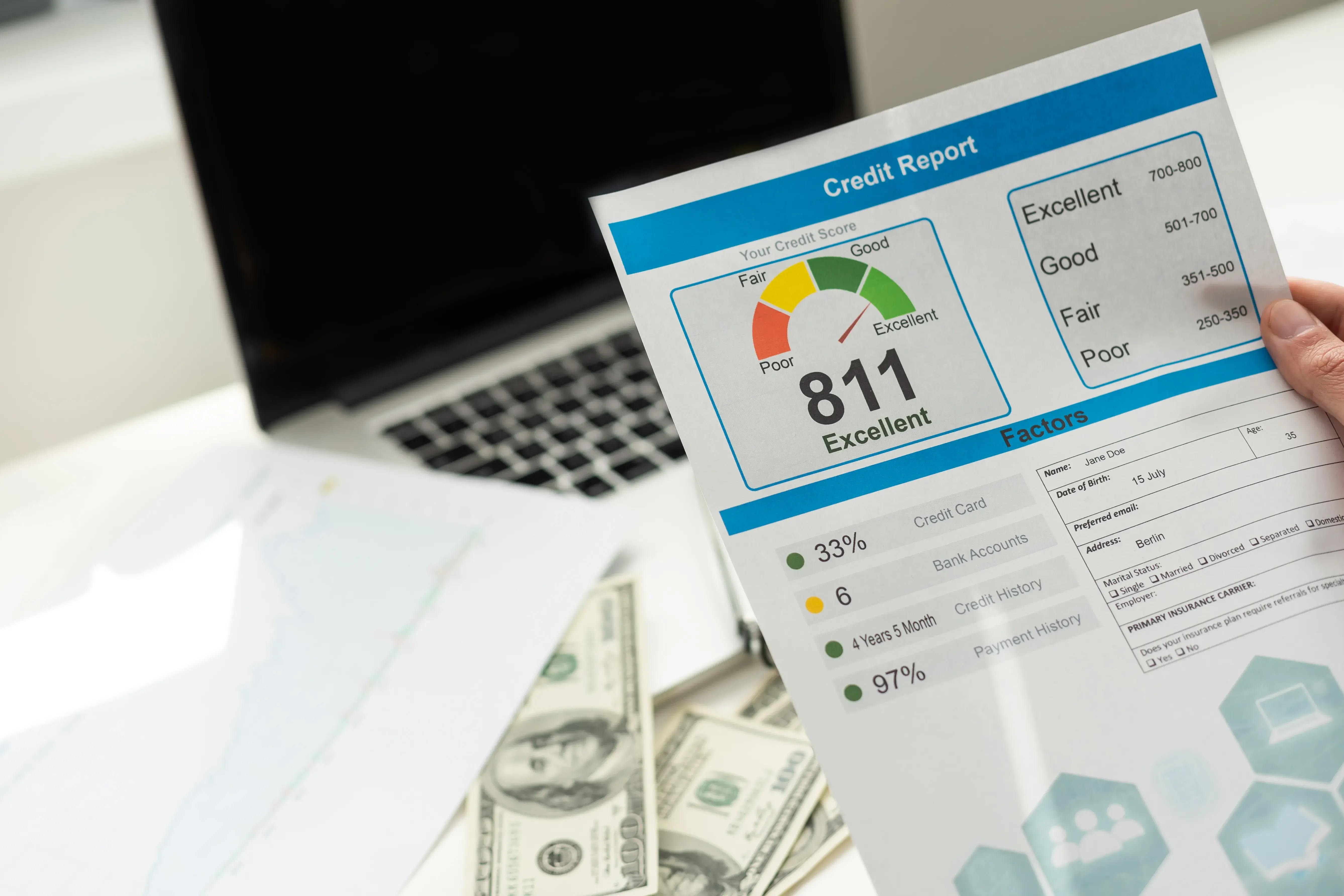-
Posted on: 24 Apr 2025

-
Safeguarding your financial identity is paramount in today's digital age. This comprehensive guide offers a clear, step-by-step process on how to lock your credit report, providing an impenetrable barrier against identity theft and fraudulent activity. Learn the essential actions to take to protect your sensitive information and gain peace of mind.
What is a Credit Report and Why Protect It?
Your credit report is a detailed record of your credit history, meticulously compiled by the three major credit bureaus: Equifax, Experian, and TransUnion. It contains information about your borrowing and repayment habits, including credit accounts, loan balances, payment history, and inquiries into your credit. This document is fundamental to your financial life, influencing your ability to secure loans, rent an apartment, obtain insurance, and even get a job. Lenders use your credit report and credit score to assess your creditworthiness – essentially, how likely you are to repay borrowed money. In 2025, the importance of this document is amplified by the increasing sophistication of cyber threats and identity theft schemes. Protecting your credit report is synonymous with protecting your financial future and your personal identity. A compromised credit report can lead to devastating consequences, including:
- Unauthorized accounts opened in your name.
- Damage to your credit score, making future borrowing difficult.
- Significant time and effort required to rectify fraudulent activity.
- Financial losses and emotional distress.
The sheer volume of personal data available online makes individuals vulnerable. From data breaches exposing Social Security numbers to phishing scams, the avenues for malicious actors to access your financial information are numerous. Therefore, understanding how to proactively shield your credit report is not just a good idea; it's a necessity for financial security in the modern world. By taking control of who can access your credit report, you erect a crucial barrier against these pervasive threats.
Understanding Credit Freezes and Fraud Alerts
Before diving into the "how-to," it's essential to grasp the distinct protective measures available: credit freezes and fraud alerts. While both aim to prevent unauthorized access to your credit, they operate differently and offer varying levels of protection.
Credit Freezes (Security Freezes)
A credit freeze, also known as a security freeze, is the most robust form of credit protection. When you place a freeze on your credit report with a bureau, it restricts access to your credit file. This means that lenders and other entities cannot pull your credit report to open new accounts in your name. If a potential creditor cannot access your credit report, they typically cannot approve new credit applications. This effectively stops identity thieves from opening new credit cards, loans, or other financial products using your stolen information. For 2025, credit freezes are widely recognized as the gold standard for identity protection. It's important to note that placing a credit freeze is free for all consumers in the United States, a right established by federal law.
Fraud Alerts
A fraud alert is a less restrictive measure. When you place a fraud alert on your credit report, it signals to potential creditors that you may be a victim of identity theft. This requires creditors to take extra steps to verify your identity before opening new credit in your name. There are two types of fraud alerts:
- Initial Fraud Alert: Lasts for one year and is suitable for individuals who suspect their information may have been compromised but haven't yet experienced identity theft.
- Extended Fraud Alert: Lasts for seven years and is intended for individuals who have already been victims of identity theft. It requires creditors to contact you directly to verify any new credit applications.
While fraud alerts add a layer of security, they are not as foolproof as a credit freeze. A determined fraudster might still find ways to bypass the verification process, especially if they have a significant amount of your personal information. For comprehensive protection, a credit freeze is generally recommended.
Comparison: Credit Freeze vs. Fraud Alert
To clarify the differences, consider this table:
Feature Credit Freeze (Security Freeze) Fraud Alert Primary Function Blocks access to your credit report, preventing new account openings. Requires creditors to verify identity before extending credit. Effectiveness Against New Accounts Very High - Prevents new accounts from being opened. Moderate - Adds a verification step, but not a complete block. Ease of Use for Existing Credit May require temporary unfreezing for legitimate credit applications. Generally does not impede existing credit management. Cost Free (as of the Credit Freeze Act of 2023) Free Recommended For Maximum protection against identity theft and new account fraud. Suspected compromise, or as a preliminary step. In 2025, the consensus among cybersecurity experts and consumer protection agencies is that a credit freeze offers the most comprehensive defense against the growing threat of identity theft. While fraud alerts can be a useful tool, they do not provide the same level of absolute prevention as a freeze.
How to Lock Your Credit Report: A Step-by-Step Guide
Locking your credit report, typically through a credit freeze, is a proactive measure that significantly enhances your identity protection. The process involves contacting each of the three major credit bureaus individually. While it might seem like a lot of steps, it's a straightforward procedure designed to be accessible to all consumers. Here’s a breakdown of the essential steps:
Step 1: Gather Necessary Information
Before you begin, ensure you have readily available the information required by the credit bureaus to verify your identity. This typically includes:
- Your full legal name.
- Your Social Security number (SSN).
- Your date of birth.
- Your current address (and previous addresses if you've moved recently).
- A government-issued photo ID (like a driver's license or passport).
- Proof of address (like a utility bill or bank statement).
Having this information organized will expedite the process and prevent potential delays.
Step 2: Contact Each Credit Bureau
You must place a freeze with Equifax, Experian, and TransUnion separately. Each bureau has its own online portal, phone number, and mailing address for requesting a freeze. It is highly recommended to use the online method for the quickest results, as phone and mail requests can take longer.
Equifax
Equifax offers an online portal for requesting a credit freeze. You can usually find this option under their "Security Freeze" or "Protect Your Identity" sections on their official website. You'll be prompted to create an account or log in, and then follow the on-screen instructions to submit your request.
Experian
Experian also provides an online service for placing a credit freeze. Visit their website and navigate to the relevant section for security freezes. Similar to Equifax, you'll likely need to provide your personal information and complete an online application.
TransUnion
TransUnion has a similar online process for requesting a credit freeze. Go to their official website, locate the security freeze option, and follow the steps to submit your request. They may also offer a dedicated portal or service for this purpose.
Step 3: Submit Your Request
Once you've accessed the freeze request portal for each bureau, carefully fill out all required fields. Double-check your information for accuracy. You will be asked to confirm your identity using the information you gathered in Step 1. After successful submission, each bureau will provide you with a confirmation and a unique Personal Identification Number (PIN) or password. This PIN is crucial for temporarily lifting or permanently removing the freeze later.
Step 4: Save Your PINs and Confirmation
This is a critical step. Each credit bureau will issue you a confirmation letter or email containing a unique PIN or password. Store these PINs in a safe and secure place, such as a password manager or a physical safe. You will absolutely need these PINs to temporarily unfreeze your credit for legitimate purposes, such as applying for a loan or a new credit card. Losing these PINs can create significant hurdles when you need to access your credit report.
Step 5: Confirm the Freeze is Active
After a few business days, it's wise to log back into each bureau's portal or check your email for confirmation that the freeze has been successfully implemented. Some bureaus may also send you a physical letter confirming the freeze. This ensures your credit report is officially locked.
Freezing Your Credit with the Three Bureaus
As mentioned, the process must be repeated for each of the three major credit bureaus. While the core principle is the same, the user interface and specific requirements might differ slightly. Here's a more detailed look at initiating a freeze with each bureau, focusing on their 2025 offerings:
Equifax Freeze Process
Online: Visit the Equifax Security Freeze page. You will be guided through a series of questions to verify your identity. You will need to provide your SSN, date of birth, and current address. After verification, you will create a username and password for your Equifax account, which will be used to manage your freeze. You will receive a confirmation and a PIN via email or mail.
Phone: Call Equifax at 1-800-349-9960. You will speak with a representative who will guide you through the freeze request. This method is generally slower than the online approach.
Mail: Download the Security Freeze Request form from the Equifax website. Fill it out completely and mail it to the address provided on the form. This is the slowest method and can take several weeks.
Experian Freeze Process
Online: Go to the Experian Freeze page. You will be asked to create an account or log in. Provide your personal details for identity verification. Upon successful verification, you will receive confirmation and a PIN, typically delivered electronically.
Phone: Call Experian at 1-888-397-3742. A customer service representative will assist you with the freeze request over the phone.
Mail: Download the freeze request form from the Experian website and mail it to the designated address. This is the least efficient method.
TransUnion Freeze Process
Online: Visit the TransUnion Freeze page. You will be prompted to create a myTransUnion account. Follow the on-screen prompts to submit your identity verification information. A confirmation and PIN will be provided upon successful completion.
Phone: Call TransUnion at 1-888-909-8872. You can request a freeze over the phone with the assistance of a representative.
Mail: Obtain the freeze request form from the TransUnion website and mail it in. This method will have the longest processing time.
Key takeaway for 2025: All three bureaus are mandated by federal law to provide free credit freezes. The online method is almost universally the fastest and most convenient. Ensure you are on the official website of each bureau to avoid scams.
Understanding the Process for Minors
Identity theft can affect children too, and their credit reports can be targeted even before they are aware of it. Protecting a minor's identity is crucial, and this involves placing a credit freeze on their behalf. The process is similar to that for adults but requires additional documentation to prove your relationship with the child.
Steps to Freeze a Minor's Credit
- Gather Documentation: You will need to prove your identity as the parent or legal guardian and your relationship to the minor. This typically includes:
- Your government-issued ID.
- The minor's Social Security card or number.
- The minor's birth certificate.
- Proof of guardianship or custody, if applicable.
- Contact Each Bureau: Similar to adult freezes, you must contact Equifax, Experian, and TransUnion individually. The online portals for minors might be slightly different, or you may be directed to a specific phone number or mailing address.
- Submit the Request: Follow the instructions provided by each bureau. You will submit your information and the minor's information, along with the supporting documents.
- Receive PINs: You will receive PINs for the minor's credit file. Keep these PINs in a secure location, as they will be needed to unfreeze the credit if the minor needs to open an account in the future (e.g., for college or a first car loan).
Important Note for 2025: Federal law now allows parents to freeze their child's credit report for free. Many parents choose to do this shortly after their child is born to prevent potential identity theft from occurring over many years.
What Happens After You Freeze Your Credit?
Once your credit report is frozen with all three bureaus, your financial security is significantly enhanced. Here's what you can expect:
New Credit Applications
If you, or someone else, attempt to open a new credit account in your name (e.g., a new credit card, a car loan, a mortgage), the creditor will be unable to access your credit report. They will be denied permission to pull your credit file. In most cases, this will result in the denial of the new credit application. This is the primary function and benefit of a credit freeze.
Existing Credit Accounts
A credit freeze generally does not affect your existing credit accounts. You can continue to use your current credit cards, make loan payments, and manage your existing financial relationships without interruption. Lenders who already have a relationship with you and need to access your credit file for legitimate reasons (like reviewing your account or offering you a pre-approved credit increase) will typically have a way to do so, often by using internal information or by temporarily lifting the freeze.
Credit Monitoring
While a credit freeze prevents new accounts, it doesn't prevent fraudulent activity on existing accounts or other forms of identity theft (like tax fraud or medical identity theft). Therefore, it's still advisable to monitor your credit reports regularly and consider using a credit monitoring service. You are entitled to one free credit report from each of the three bureaus every week through AnnualCreditReport.com in 2025.
Potential Inconveniences
The main inconvenience of a credit freeze is when you need to apply for new credit yourself. For example, if you're applying for a mortgage, a car loan, or even some rental agreements, you will need to temporarily lift the freeze. This is why keeping your PINs safe is paramount.
Unfreezing Your Credit When Needed
When you need to apply for new credit, rent an apartment, or undergo a background check that requires a credit pull, you'll need to temporarily lift the freeze. This is a simple process that also requires your PIN.
How to Temporarily Lift a Freeze
- Contact Each Bureau: You must contact Equifax, Experian, and TransUnion individually to request a temporary lift.
- Provide Your PIN: You will need to provide your unique PIN or password for each bureau.
- Specify the Duration: You can usually request the freeze to be lifted for a specific period (e.g., 24 hours, 48 hours, or a few days) or for a specific company. Some bureaus allow you to specify a date range for the unfreeze.
- Online, Phone, or Mail: Similar to placing a freeze, you can typically request a temporary lift online, by phone, or by mail. The online method is usually the fastest.
Important Note for 2025: Temporary unfreezing is also free of charge. Plan ahead when you know you'll need to apply for credit, as it might take a day or two for the unfreeze to be fully processed by all bureaus.
How to Permanently Remove a Freeze
If you decide you no longer want the protection of a credit freeze, you can permanently remove it. The process is similar to lifting it temporarily, but you will request a permanent removal instead of a temporary lift. You will still need your PIN.
- Contact Each Bureau: Reach out to Equifax, Experian, and TransUnion.
- Provide Your PIN: Supply your unique PIN for each bureau.
- Request Permanent Removal: Clearly state that you wish to permanently remove the security freeze.
- Confirmation: You will receive confirmation that the freeze has been permanently removed.
Consideration for 2025: While you can permanently remove a freeze, many cybersecurity experts recommend keeping it in place indefinitely, especially given the persistent threat of identity theft. You can always lift it temporarily when needed.
Alternatives to Credit Freezes
While credit freezes are the most robust protection, other measures can supplement your security strategy or serve as alternatives if a freeze isn't suitable for your immediate needs. These include:
Credit Monitoring Services
These services track your credit activity across the major bureaus and alert you to significant changes, such as new account openings, credit inquiries, or changes in your credit score. While they don't prevent fraud, they can provide early detection, allowing you to act quickly. Many paid services offer additional features like identity theft insurance.
Identity Theft Protection Services
These comprehensive services often bundle credit monitoring with other features like dark web monitoring, social media monitoring, and restoration assistance if your identity is compromised. They offer a broader safety net but are typically more expensive than basic credit monitoring.
Monitoring Your Credit Reports Directly
As mentioned, you are entitled to a free credit report from each of the three major bureaus every week via AnnualCreditReport.com. Regularly reviewing these reports can help you spot suspicious activity. This is a free but more hands-on approach.
Securing Your Online Accounts
Using strong, unique passwords for all your online accounts, enabling two-factor authentication (2FA) wherever possible, and being wary of phishing attempts are fundamental steps in preventing your personal information from being compromised in the first place. For 2025, robust cybersecurity practices are more critical than ever.
When might these be alternatives? If you frequently apply for new credit and find the process of lifting and re-freezing too cumbersome, a combination of fraud alerts and diligent credit monitoring might be a more manageable approach. However, for maximum protection against new account fraud, a credit freeze remains the most effective tool.
Best Practices for Ongoing Credit Security
Protecting your credit report and identity is not a one-time task; it's an ongoing commitment. By incorporating these best practices into your routine, you can significantly reduce your risk of becoming a victim of identity theft in 2025 and beyond.
Regularly Review Your Credit Reports
As stated, you can get free weekly reports from Equifax, Experian, and TransUnion at AnnualCreditReport.com. Scrutinize each report for any accounts you don't recognize, inquiries you didn't authorize, or personal information that is incorrect. Report any discrepancies immediately to the credit bureau and the creditor involved.
Enable Two-Factor Authentication (2FA)
Wherever possible, enable 2FA on all your online accounts, especially financial ones. This adds an extra layer of security, requiring a second form of verification (like a code sent to your phone) in addition to your password.
Be Wary of Phishing and Scams
Never click on suspicious links in emails or text messages, and never provide personal information in response to unsolicited requests. Legitimate organizations will rarely ask for sensitive data via email or text. If in doubt, contact the organization directly through a known, trusted channel.
Secure Your Mail
Use a secure mailbox, especially if you receive sensitive documents. Consider opting for electronic statements whenever possible to reduce the amount of sensitive information sent through the postal service.
Shred Sensitive Documents
Before discarding any documents containing personal or financial information (like old bank statements, credit card offers, or medical bills), shred them thoroughly. This prevents "dumpster divers" from accessing your data.
Use Strong, Unique Passwords
Avoid using easily guessable passwords like birthdays or common words. Use a combination of upper and lowercase letters, numbers, and symbols. Consider using a password manager to create and store complex passwords for all your online accounts.
Monitor Your Financial Accounts
Regularly check your bank statements and credit card statements for any unauthorized transactions. Report any suspicious activity to your financial institution immediately.
Consider a Credit Freeze for Children
As discussed, freezing your child's credit report from birth can provide lifelong protection against identity theft.
Stay Informed About Data Breaches
Keep an eye on news about major data breaches. If a company you do business with experiences a breach, take extra precautions to monitor your accounts and consider placing a fraud alert or credit freeze if your information was potentially exposed.
By diligently applying these practices, you build a robust defense system against identity theft, ensuring your financial future remains secure. The proactive step of locking your credit report is a cornerstone of this strategy.
Conclusion
In the increasingly complex digital landscape of 2025, proactively protecting your financial identity is no longer optional—it's essential. Locking your credit report, primarily through the mechanism of a credit freeze, stands as one of the most powerful defenses against identity theft and new account fraud. By following the step-by-step guide outlined in this article, you can effectively place a freeze with Equifax, Experian, and TransUnion, creating a significant barrier that prevents unauthorized access to your credit file. Remember to gather your necessary information, navigate each bureau's specific process, and most importantly, securely store the PINs provided. These PINs are your key to temporarily unfreezing your credit when you need to apply for legitimate credit, ensuring that your protection doesn't hinder your financial progress. While alternatives like fraud alerts and credit monitoring offer valuable layers of security, the credit freeze provides an unparalleled level of prevention against new account fraud. By combining a credit freeze with other best practices, such as regularly monitoring your credit reports, enabling two-factor authentication, and staying vigilant against phishing scams, you can build a comprehensive and robust identity protection strategy. Take control of your financial security today by locking your credit report and safeguarding your future.
Faq
1: What does it mean to lock my credit report?
Locking your credit report restricts access to your credit file, preventing lenders or creditors from opening new accounts in your name without your permission.
2: How is a credit lock different from a credit freeze?
A credit freeze is a legal restriction regulated by state law, while a credit lock is a service provided by credit bureaus. Both prevent unauthorized access, but locks can be turned on and off more quickly via apps or online portals.
3: Can locking my credit report prevent identity theft?
Yes, locking your credit report helps protect against new account fraud. However, it does not stop misuse of existing accounts, so ongoing monitoring is still recommended.
4: How do I lock or unlock my credit report?
You can lock or unlock your credit report directly through the major credit bureaus—Experian, Equifax, and TransUnion—using their websites or mobile apps.
5: Does locking my credit report affect my credit score?
No. Locking or freezing your credit report does not impact your credit score, and you can still use your existing credit cards and accounts as usual.











